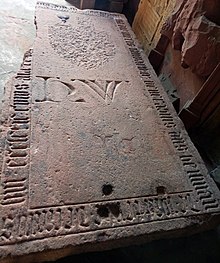Heilmann von Wattenheim
Heilmann von Wattenheim also Heylmann von Wattenheim (* approx. 1345; † January 12, 1411 in Neustadt an der Weinstrasse ) was a noble priest, papal representative, canon and dean (head) of the Liebfrauen Collegiate monastery in Neustadt an der Weinstrasse .
biography
Heilmann von Wattenheim came from the low-nobility family of the same name, which was based in the Hessian town of Wattenheim (Biblis) and often appears as a fiefdom in connection with the diocese of Worms and the Electoral Palatinate . The noble couple Heilmann and Ella , who received the place Wattenheim as a fief from the Archdiocese of Mainz in 1354 , could possibly be his parents.
In 1356 , due to the will of his brother Rudolf II , Elector Ruprecht I founded the Liebfrauen- Kollegiatstift Neustadt as a memorial for the common family. He was headed by the dean of the monastery.
As early as 1368, Elector Ruprecht I presented the cleric Heilmann von Wattenheim to Neustadt Abbey as a canon, which suggests a connection to the Palatinate Wittelsbachers . Subsequently he became treasurer of the community and curator of the collegiate church. From the year 1400, the clergyman appears in a document as dean of the Liebfrauen Collegiate Foundation in Neustadt an der Haardt (today Neustadt an der Weinstrasse).
Around the same time, Pope Boniface IX appointed him . to the main executor of papal privileges at the University of Heidelberg , soon also to the papal legate for the parishes belonging to the Heidelberg University since 1400, which had been withdrawn from the responsible diocesan bishops and were directly subordinate to the Pope. The Holy See entrusted the administration of these parishes to the Neustadt monastery dean, who thus rose to the rank of papal archdeacon . Heilmann von Wattenheim exercised the papal powers to which he was entitled in numerous cases. It was the patronage of the parish church of St. Laurentius in Altdorf near Nuremberg and the parishes of St. Jakob in Lauda and St. Peter in Heidelberg . In addition, one canonical prebend each at the Speyer Cathedral , one at the Worms Cathedral and one at the Julianastift zu Mosbach , as well as two canonical prebends each at the Petersstift Wimpfen and at the Worms Abbey of St. Andreas , St. Paulus and St. Cyriakus .
According to the Seelbuch of the Neustadt collegiate monastery, Heilmann von Wattenheim died on January 12, 1411 and was buried in the associated collegiate church . His grave slab was discovered under the floor during a renovation of the Protestant part of the church at the beginning of the 20th century. She is now in the paradise of the church. In addition to a Gothic majuscule inscription , it bears the large initials HW in the middle , as well as the relief image of a chalice; a once existing coat of arms was knocked out.
literature
- Alban Haas : From the Nüwenstat; on the development and life of medieval Neustadt an der Weinstrasse , Pfälzische Verlagsanstalt, Neustadt, 1964, page 86
- Silke Burkhardt: Famous grave monuments in the Neustadt collegiate church , Historical Association, Neustadt district group, 1984, pages 78 and 79
- Johann Friedrich Hautz: History of the University of Heidelberg , Mannheim, 1862, Volume 1, Pages 229 and 230; Scan from the source to the parishes looked after on behalf of the papal
Individual evidence
- ^ Georg Wilhelm Justin Wagner : The desertions in the Grand Duchy of Hesse , Volume 2 (Province of Starkenburg), Historical Association for the Grand Duchy of Hesse, 1862; Scan from the source
- ^ Johann Friedrich Böhmer : Regest of the Archbishops of Mainz from 1289 to 1396 , Volume 1, Page 166, 1913; Excerpt from the source
- ↑ On the founder of the monastery and the purpose of the memoria for the House of Wittelsbach
- ^ Website of St. Laurentius Altdorf with mention of the patronage of the University of Heidelberg
- ↑ Website on the parish church of St. Jakob in Lauda
- ^ Website of the Peterskirche Heidelberg, with mention of the patronage of the university
| personal data | |
|---|---|
| SURNAME | Wattenheim, Heilmann from |
| ALTERNATIVE NAMES | Wattenheim, Heylmann from |
| BRIEF DESCRIPTION | German priest, dean and legate |
| DATE OF BIRTH | around 1345 |
| DATE OF DEATH | January 12, 1411 |
| Place of death | Neustadt an der Weinstrasse |
